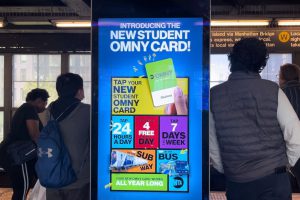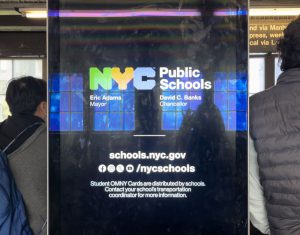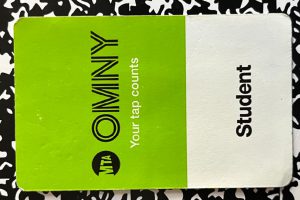The little ribbon screens inside the subway carts flash every other instance with various images. Sometimes they display some subway etiquette tips for riders, such as “Seats are for butts not bags,” “Watch your bag” or “Throw it [one’s trash] out before it gets ugly.” Other times, the screens show advertisements for different products.

The vertical screens on the subway platforms show similar images. They alternate between collaborations of poets and artists for the MTA’s “Poetry in Motion” series, reminders by the MTA and the NYPD that fares are “required to ride” and that “MTA fare inspectors and the NYPD are enforcing fare payment,” or even suggestions by the New York Presbyterian advising New Yorkers to lower their screen time for a boost in mental health.
One announcement, in particular, introduces a new method for paying the MTA fare with vibrant graphics: the OMNY card. This colorful image then fades into a black screen with the NYC Public Schools logo and the names of Mayor Eric Adams and Chancellor David C. Banks underneath.

In the past, eligible NYC public school students in grades K-12 were given a full or half-fare MetroCard for their commute. This academic year, the student MetroCard was replaced with the student OMNY card. This new, small, green paper card embedded with a chip offers students new perks— four free rides for all days, including weekends, and at all hours. This card is valid for students from the beginning of the school year (in September) through the end of the summer.
Though the MTA has future plans to completely phase out the MetroCard by 2025 by slowly implementing OMNY cards, transportation accessibility for college students does not seem to be in those plans yet.

Hunter student Evelyn Morales believes that making OMNY cards available to college students would be “very helpful since a lot of college students have to work and have to make a living on top of going to class.”
According to their website, Hunter College tuition is $6,930 per year for full-time, in-state students and $18,600 per year or $620 per credit for full-time, out-of-state residents. This amount, however, does not take into account the additional textbook and material fees, and transportation costs students need to pay.
Morales is a freshman psychology student who spends time on campus five days a week. For three of those days, she has big gaps in her schedule which she spends in the library. She commutes to Hunter via the subway and estimates that she spends about $29 on a MetroCard weekly.
The student OMNY cards are being funded in part by the state and in part by the city (New York City Public Schools, the Department of Transportation).
According to the website of Professional Staff Congress (PSC-CUNY), a union that advocates for a New Deal for CUNY, in which CUNY is fully funded, CUNY’s funds also come from the state and city, as well as from some federal grants.
Vadim Berdov is a senior human biology student who spends two days a week on campus for around five to six hours a day. Berdov says “When I have a gap I spend time in the north building on the first floor or outside.” Like Morales, he also primarily uses the subway to get to Hunter and estimates spending around $30 – $40 on a Metrocard that he uses for about one and a half to two weeks.
The MTA Press Office was contacted for a response regarding the accessibility of the OMNY cards for college students but The Athenian was unable to receive a response because they do not accommodate inquiries for student publications.
Ariadna Silva and Daphne Illescas are two members of NYPIRG, a non-profit student advocacy organization at Hunter.
Silva notes that “a lot of CUNY students come from public NYC schools” and thus have the experience of receiving a school Metrocard in high school. When entering college, many of these students face an “added financial burden” in paying their commute costs, on top of tuition, textbook fees, homework access codes, and materials. Silva says, “I don’t think students should be having to consider ‘Should I pay my fare or go hungry?’”
Illescas also adds that having free MetroCards provided high school students “a way to get an education and try to build [their] life” but that here, in college, the situation is not the same. She asks, “If you could barely afford tuition how are you going to afford your way here?”
NYPIRG’s two current campaigns regarding student fares are the New Deal for CUNY
and the Straphangers Campaign, according to Silva. A fully funded CUNY would allow for expanding student resources, such as having more advisors or having free MetroCards/OMNY cards. Within the Straphangers Campaign, they are fighting to expand who can qualify for reduced fares so that it includes CUNY students too.
Illescas suggests students get involved “and getting involved in NYPIRG is simply just attending a meeting, signing one of our info cards.” The NYPIRG meetings take place on Tuesdays at 2:30 p.m. in W215.
Silva agrees and notes the successes NYPIRG has had so far (increased TAP funding, for example) and future advances are “only possible because students come and show up.”










